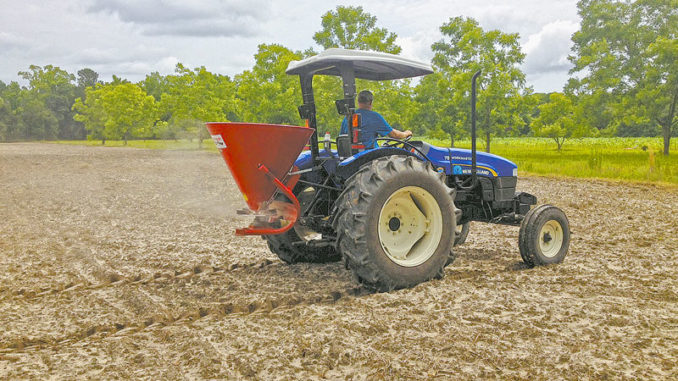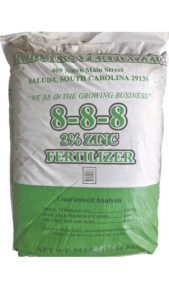
Soil Tests Can Point To Needed Chemical Applications
Every hunter that has time and money invested in a food-plot program wants to see results in more ways than one. As fall arrives, hunters would love to see a big-racked buck making regular visits to their food plot. That’s where blood, sweat, and tears have taken hold.
Ultimately, most hunters hope to shoot a nice deer in their plots. But most land managers will credit their hard work as successful when a solid source of nutrition is created and used regularly by the local herd. In order to create these nutrient-rich meccas, it starts at the ground level, literally, with a soil test. But what do all of these numbers mean?
Everything grows from the dirt, and having the right chemical composition will directly affect the outcome and the potential uses by wildlife. A soil test is the first step to creating an ideal food source for wildlife. Soil tests allow hunters and property managers to make precise and accurate soil amendments to create the ideal chemical environment for their intended food-plot plans.
It’s The Chemistry
Plants require a specific chemical environment to survive and thrive. Whether growing peanuts, corn or soybeans in Williamsburg County, S.C., or bright, green turf grass on one of the world-famous golf courses in North Carolina’s Sandhills, soil chemistry is the starting point.
Soil tests are about as inexpensive as a hamburger combo at a fast-food place and very easy to collect. But after the results return, how should one interpret them and use them to his advantage?
Test results produce lots of numbers that can look foreign for people not adapted to reading them. All of the reported numbers contribute to the success of the crop. But several key numbers will have the biggest impact on the crop’s outcome.
Pay close attention to these two numbers first
You should pay close attention to the pH and the buffer pH first. The soil pH is the groundwork for all chemical reactions in the soil. Plants need nutrients. And the specific pH of the soil determines what nutrients will be soluble and usable to plants, and what nutrients will be held unavailable. A soil pH of 7.0 is considered neutral. Anything less is considered acidic. Most agriculture plants flourish when soil pH is slightly neutral or between 6.5 and 7.0.
The buffer pH value illustrates how adding lime can effectively raise the pH to desired levels. Buffer pH is produced in the soil laboratory after a controlled alkaline solution is added to the soil sample. The difference in the soil pH and the buffer pH values will determine how effective a lime treatment can adjust the soil pH. A wide range between soil pH and buffer pH essentially means a lime treatment will have a dramatic effect on the soil pH. By contrast, a small difference between the two values means lime won’t have a big effect on the soil pH.
How Soil Responds To Lime
The amount of organic content and the soil texture determine the effectiveness and prescribed interval of lime treatments and the buffer pH values. Soils high in organics and clay content in the soil have a high reserve acidity. This takes longer to convert to higher pHs with alkaline solutions. But fewer lime applications are required after pH values have been adjusted, compared to sandy soils. Well-drained, sandy soil will respond quickly to lime. But it must be added frequently due to important chemicals leaching out of the root zone.
As a rule of thumb, both sandy and clay soils will need recurrent lime applications over time. However, sandy soils can receive an annual burst of a quick-liming product 30 to 45 days before planting to have a positive affect on soil productivity. Clay-based soils should be limed using slow-release dolomitic lime in several split applications every few years.
In addition to the soil pH, the soil sample shows the levels of macro- and micro-nutrients. These nutrients are important for successful plant survival and the potential for rigorous growth. Fortunately, nearly all of the listed soil nutrients can be supplemented . And they are usable to plants as long as the soil pH is within an ideal soil pH range. It’s important to note that using fertilizers high in potassium and phosphorus in very acidic soils isn’t recommended. That’s because these two elements will be insoluble to plants.
Neutral pH Is Best
Chemicals react and form compounds in the soils that can be either soluble or insoluble for plants. Most soil chemical compounds are more usable to plants when located in a near neutral pH environment. Generally, soil chemicals are reported in pounds per acre. And most soil laboratories provide an indicator chart showing whether levels are deficient, sufficient, high or other relative factor language.
Fortunately, soil-laboratory reports have an easy button. This gives landowners summary recommendations to help assist in application rates. These are given in per acre amounts. And some reports even show the recommended rates for specific plant groups, such as: legumes, grasses, brassicas, etc.
Soil testing is an economic but vital component to all food-plot preparation schedules. And the reports can be easy to interpret when the basic components are understood.
 Fertilizer Calculations Made Easy:
Fertilizer Calculations Made Easy:
Soil test results make it easy for landowners to make fertilizer applications on their land for their fall food plots. All plants need a wide variety of soil nutrients in order for a bountiful crop to flourish. And commercial fertilizers are an easy way to improve the nutrient availability in the soil. But how much does it take to provide the necessary nutrients for the field?
Not everybody likes math. But figuring out how many bags of fertilizer to add is relatively simple without any treacherous calculus, geometry or advanced algebra.
Fertilizers contain both macro-nutrients and micro-nutrients where the composition by percent volume is reported on the label. Most labels will show the major macro-nutrients in the three-digit label (#-#-#) that equates to the percent volume of Nitrogen-Phosphorus-Potassium. Other nutrients are located on the more-detailed accounting of the label where the remaining micro-nutrients are included. Land managers can easily calculate the amounts of nutrients necessary by using the weight of the bag, percent volume of each nutrient on bag, and then by the area of treatment.
Here is a simple example to demonstrate the math. A landowner is planting a one-acre food plot, and the recommendation is for 70 pounds of phosphorus per acre —that was all that was required. A 40-pound bag of triple super-phosphate is labeled as 0-46-0. Forty-six percent of the 40-pound bag is phosphate — 18.4 pounds per bag. For the 70 pounds of recommended phosphorus, it would require four 40-pound bags or 160 pounds. At this rate, it would provide approximately 73.6 pounds of phosphorus from the four 40-pound bags.
Typically, most farmers apply fertilizers with a mixture of both micro- and macro-nutrients so they can meet all of the nutrient needs at one time. The percentage of the nutrients can be easily calculated using the same method as with the triple super-phosphate above.

 Fertilizer Calculations Made Easy:
Fertilizer Calculations Made Easy: